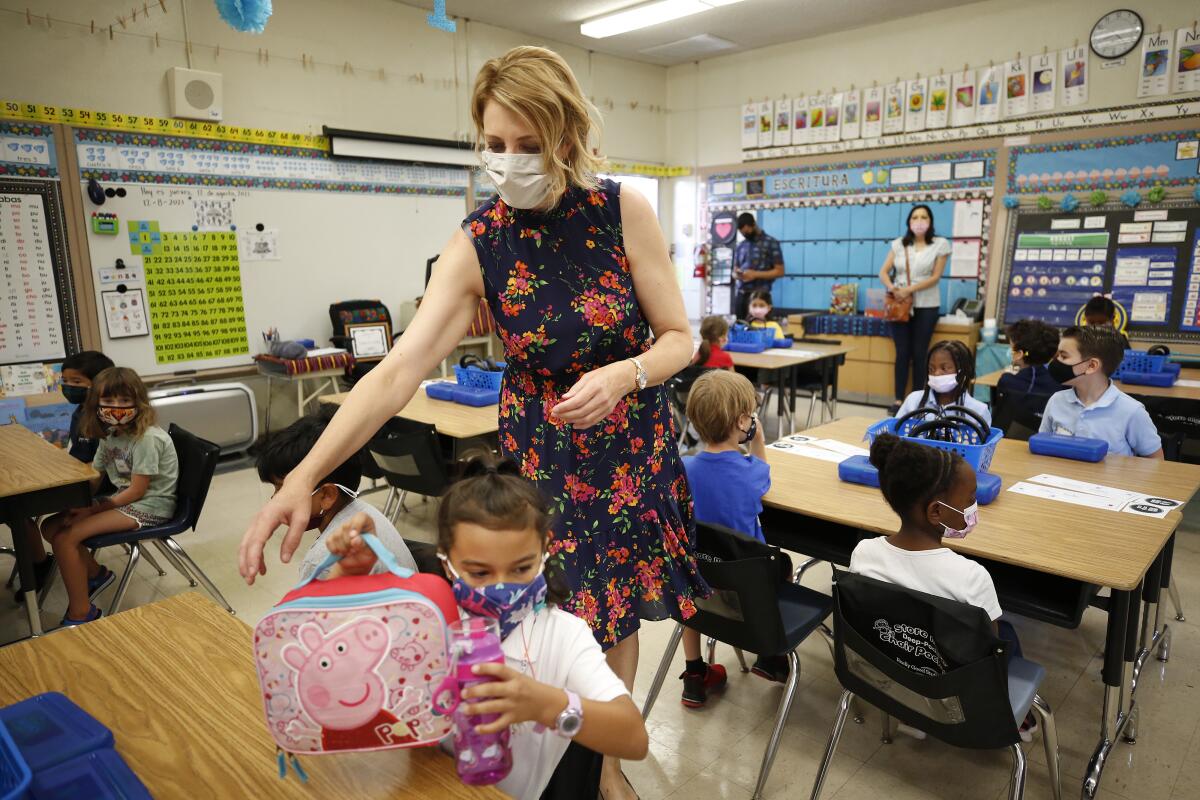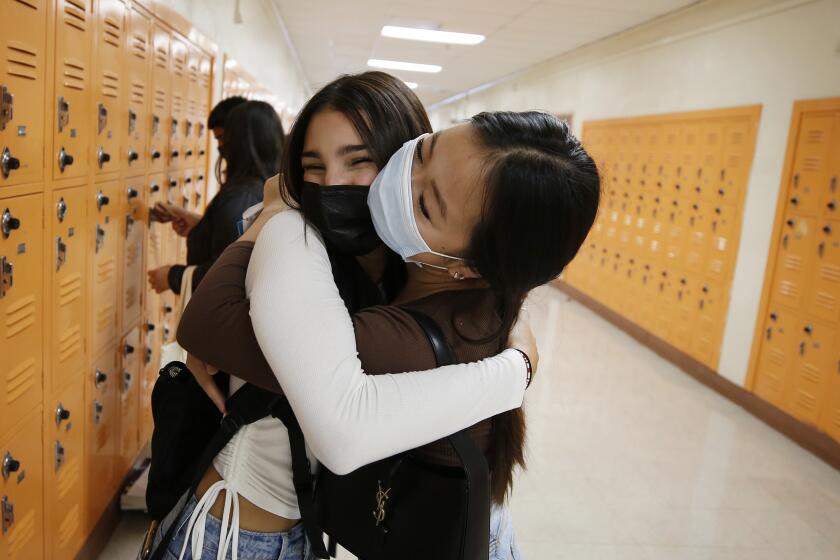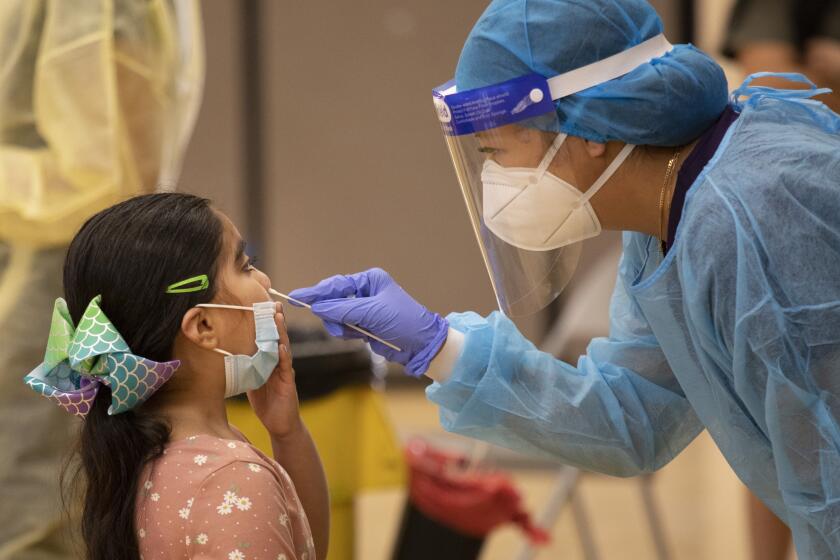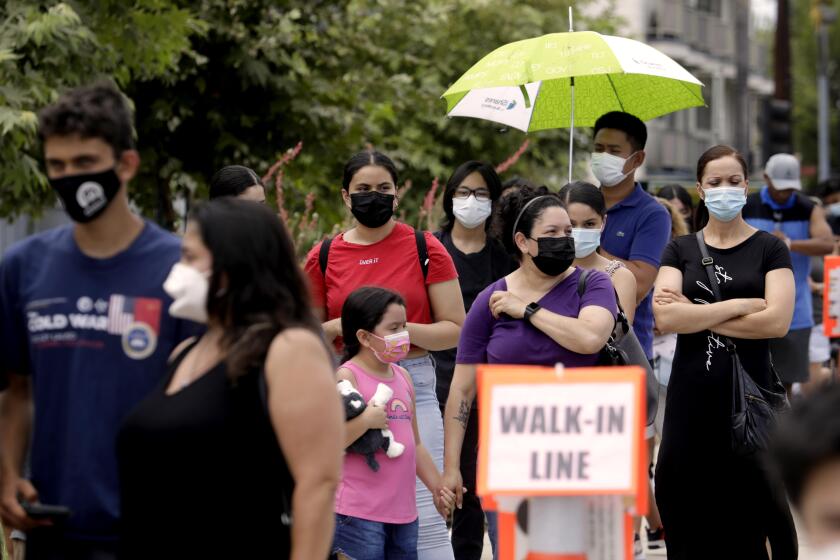What are the risks of kids getting COVID-19 as schools reopen?

With children going back to school — in some cases, for the first time since the pandemic began — many parents are wondering about the risks of their children contracting the coronavirus.
California is seeing COVID-19 hospitalizations for children rise as the ultra-contagious Delta variant dominates the nation, but rates in the state remain well below the winter high and relatively low overall.
Here is a breakdown of what we know:
The numbers
In California, there have been about 18 new COVID-19 hospitalizations a day for children up to age 17 over a recent seven-day period.
That’s worse than it was in mid-June, when pediatric hospitalizations in children reached close to zero. But the latest hospitalization numbers are still below the peak of about 29 new COVID-19 hospitalizations a day recorded in January, according to the U.S. Centers for Disease Control and Prevention.
Students across California are returning to a very different school experience. Here are answers to common questions about vaccines, testing, masks and more.
California’s latest hospitalization rate among children is 10% that of the rate for adults in their 30s.
COVID-19 deaths among children remain relatively low. Of a cumulative COVID-19 death toll of more than 64,000 Californians, 30 fatalities statewide have been among children. And of nearly 25,000 COVID-19 deaths in Los Angeles County, two have been in children under the age of 12, and four deaths have been among those ages 12 to 17.
Nationally, there have been more than 400 deaths among children up to age 17. In comparison, 756 children died by unintentional drowning in 2019.
Nationwide, there are now about 272 children newly hospitalized a day for COVID-19, a 23% increase from the previous peak in winter.
Child COVID-19 hospitalization rates hit record in U.S. — but not in California. Here’s why
California comparison
That national boom in pediatric hospitalizations has been driven largely by a few states. Four states are responsible for nearly half of new daily hospitalizations for COVID-19 among children: Florida, which is reporting 54 new pediatric hospitalizations a day over a recent seven-day period; Texas, 39; and Alabama and Georgia are each reporting 24 new hospitalizations a day.
As more than 1,000 schools reopen amid rising case counts, the district’s massive coronavirus testing effort is central to keeping schools safe.
Most of the states that have higher-than-average per capita rates are in the South. They include Louisiana, Montana, Mississippi, Tennessee, West Virginia, Missouri and Arkansas.
Among the nation’s three most populous states, the rate for new daily pediatric hospitalizations for COVID-19 per 100,000 children in Florida is 1.28; in Texas, it’s 0.53; and in California, it’s 0.21. Nationally, the rate is 0.37.
California’s relatively better pediatric hospitalization rate is likely a result of relatively higher vaccination rates. Children under the age of 12 are not yet eligible for vaccines but can be better protected from COVID-19 if teenagers and adults around them are fully vaccinated.
The states with the nation’s worst pediatric new daily hospitalization rates all have percentages of full vaccination lower than the national rate, ranging from 35% (Alabama) to 50% (Florida). Some of those states, such as Florida and Texas, also have banned local governments and schools from imposing mandatory mask mandates, although some local officials have pursued mask orders anyway, fearing a higher rate of disease if they don’t act.
Across the nation, 51% of residents are now fully vaccinated. California is slightly above average, with 54% of its residents fully vaccinated. California requires mask use in indoor school settings.
“Where we have higher rates of infection among children is where we have lower rates of vaccination,” Dr. Rochelle Walensky, director of the CDC, said at a briefing. The best way to keep children safe, in schools or otherwise, “is to vaccinate everyone who can be vaccinated — vaccinate family members of children who cannot yet be vaccinated — and then to follow the mitigation strategies in our school guidance, including masking in schools.”
Students returned amid excitement and trepidation — while enduring lengthy waits to get inside campuses
What experts expect
COVID-19 outbreaks have been increasing in L.A. County schools and programs in recent weeks, although not to the same extent as during last year’s autumn and winter surge. Out of 25 outbreaks that occurred between April and July, more than half were associated with youth sports and inconsistent mask wearing; socializing outside of games and practices; or traveling and lodging together during training camps and athletic events.
Federal health officials say it’s expected that hospitalization rates will rise among children given the nature of the Delta variant, which is at least twice as transmissible as the Alpha variant and produces up to 1,000 times more levels of virus in the upper throat compared with Alpha, said Dr. Anthony Fauci, the U.S. government’s top infectious diseases expert.
“The Delta variant is much more highly transmissible than was Alpha. So, given that, you will see more children likely get infected,” Fauci said at a recent briefing.
There is no definitive evidence that children are suffering greater severity of disease from the Delta variant, Fauci said, although it remains a possibility.
The health department on Sunday recorded 3,356 new cases of the virus and eight related deaths but said the real number is likely higher due to weekend reporting delays.
Assessing the risks to kids
In Los Angeles County, Public Health Director Barbara Ferrer offered reassurance to parents nervous about sending children too young to be vaccinated back into classrooms. The risk is not zero, she said, but relatively high rates of vaccination among teacher and school staff offer far more protection for children than at any earlier point in the pandemic, in addition to masking requirements indoors.
“Children are still much less likely — especially younger children — than adults to end up getting infected,” Ferrer said. “They have some of the lowest hospitalization rates, which means — even when they’re getting infected — they’re still much less likely to end up with serious illness.”
In addition, children are likely more protected in California than elsewhere because of relatively more stringent requirements aimed at protecting children, Ferrer said. As school resumes, California students are required to wear masks in indoor settings, a sharp contrast to statewide approaches in Florida and Texas, which have banned local mask mandates, though some schools are ordering masks be worn anyway.
“We’ve also had other strategies here in California and in some ways more stringent requirements than some other places,” Ferrer said, which has “protected everyone from what I call unfettered transmissions. So I think that plays in with younger people.”
Some schools in Los Angeles County reopened for in-person learning last spring, and viral transmission in those schools was less than in the surrounding community, Ferrer said.
Younger children have also been less likely to contract the coronavirus because they have far fewer proteins called ACE2 receptors in their noses, which the coronavirus needs to access to infect the body.
Experts have urged that parents get children tested if they see symptoms of illness consistent with COVID-19, such as fever, chills, difficulty breathing, fatigue, body aches, headaches, loss of taste or smell, sore throat, runny nose, nausea or diarrhea.
More to Read
Start your day right
Sign up for Essential California for news, features and recommendations from the L.A. Times and beyond in your inbox six days a week.
You may occasionally receive promotional content from the Los Angeles Times.













